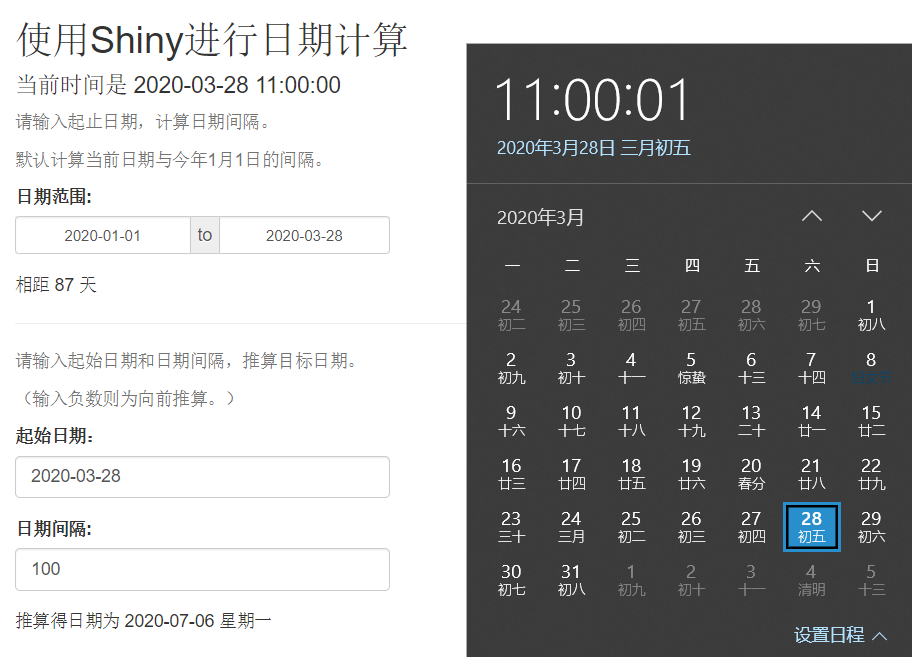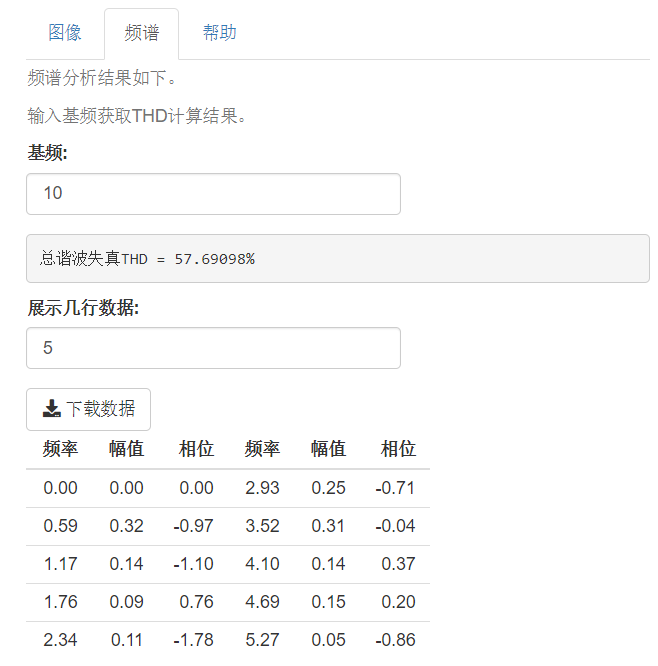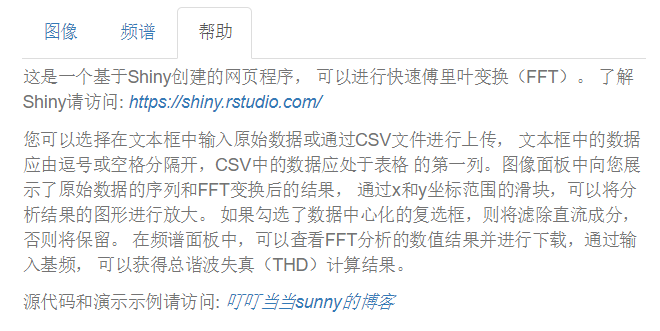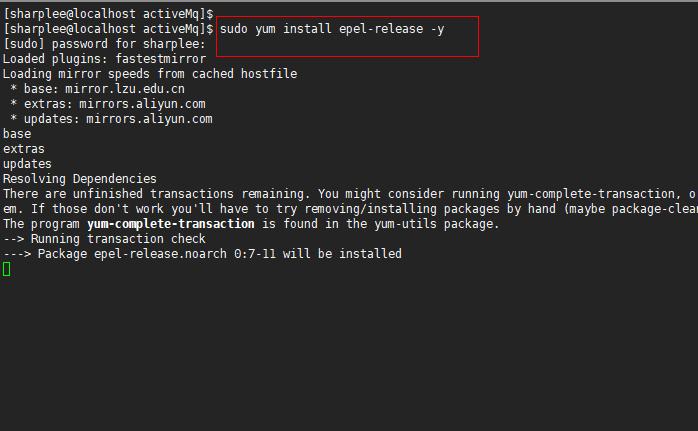R|Shiny練習
- 2020 年 3 月 28 日
- 筆記
參考:https://docs.rstudio.com/shinyapps.io/
1. 日期計算
鏈接:https://dingdangsunny.shinyapps.io/DateCalculate/
練習Shiny基本輸入輸出。
library(shiny) ui <- fluidPage( titlePanel("使用Shiny進行日期計算"), h4(textOutput("currentTime")), helpText("請輸入起止日期,計算日期間隔。"), helpText("默認計算當前日期與今年1月1日的間隔。"), dateRangeInput(inputId = "daterange", label = "日期範圍:", start = as.Date(paste(format(Sys.time()+8*60*60, "%Y"), "/01/01",sep = ""), "%Y/%m/%d"), end = as.Date(format(Sys.time()+8*60*60, "%Y/%m/%d"), "%Y/%m/%d")), textOutput("datedif"), tags$hr(), helpText("請輸入起始日期和日期間隔,推算目標日期。"), helpText("(輸入負數則為向前推算。)"), dateInput(inputId = "date", label = "起始日期:"), numericInput(inputId = "days", label = "日期間隔:", value = 100), textOutput("dateaft") ) server <- function(input, output, session) { output$currentTime <- renderText({ invalidateLater(1000, session) paste("當前時間是", Sys.time()+8*60*60) }) output$datedif <- renderText({ paste("相距", diff(input$daterange), "天") }) output$dateaft <- renderText({ d <- input$date + input$days paste("推算得日期為", d, format.Date(d,"%A")) }) } shinyApp(ui = ui, server = server)
這裡時間加8小時調整一下時區。
介面:

APP鏈接:https://dingdangsunny.shinyapps.io/DateCalculate/
2. FFT
關於FFT(快速傅里葉變換):https://www.cnblogs.com/dingdangsunny/p/12573744.html
鏈接:https://dingdangsunny.shinyapps.io/FastFourierTransform/
2.1 源程式碼
global.R
library(dplyr) FFT<-function(data, Fs, isDetrend=TRUE) { # 快速傅里葉變換 # data:波形數據 # Fs:取樣率 # isDetrend:邏輯值,是否進行去均值處理,默認為true # 返回[Fre:頻率,Amp:幅值,Ph:相位(弧度)] n=length(data) if(n%%2==1) { n=n-1 data=data[1:n] } if(n<4) { result<-data.frame(Fre=0,Amp=0,Ph=0) return(result) } if(isDetrend) { data<-scale(data,center=T,scale=F) } library(stats) Y = fft(data) #頻率 Fre=(0:(n-1))*Fs/n Fre=Fre[1:(n/2)] #幅值 Amp=Mod(Y[1:(n/2)]) Amp[c(1,n/2)]=Amp[c(1,n/2)]/n Amp[2:(n/2-1)]=Amp[2:(n/2-1)]/(n/2) #相位 Ph=Arg(Y[1:(n/2)]) result<-data.frame(Fre=Fre,Amp=Amp,Ph=Ph) return(result) } SUB<-function(t,REG) { # 通過正則表達式提取輸入數據 m<-gregexpr(REG, t) start<-m[[1]] stop<-start+attr(m[[1]],"match.length")-1 l<-length(start) r<-rep("1",l) for(i in 1:l) { r[i]<-substr(t,start[i],stop[i]) } return(r) } #生成示例訊號 deg2rad<-function(a) { return(a*pi/180) } N = 256 Fs = 150 t = (0:(N-1))/Fs wave = (5 + 8*cos(2*pi*10.*t) + 4*cos(2*pi*20.*t + deg2rad(30)) + 2*cos(2*pi*30.*t + deg2rad(60)) + 1*cos(2*pi*40.*t + deg2rad(90)) + rnorm(length(t))) %>% paste(collapse = ",")
ui.R
library(shiny) shinyUI(fluidPage( titlePanel("使用Shiny進行FFT分析"), sidebarLayout( sidebarPanel( selectInput(inputId = "input_mode", label = "選擇一種數據輸入方式", choices = c("文本輸入", "上傳文件")), textAreaInput(inputId = "data", label = "原始數據:", value = wave, rows = 10), fileInput("file", "選擇CSV文件進行上傳", multiple = FALSE, accept = c("text/csv", "text/comma-separated-values,text/plain", ".csv")), checkboxInput("header", "是否有表頭", TRUE), radioButtons("sep", "分隔符", choices = c("逗號" = ",", "分號" = ";", "製表符" = "t"), selected = ","), numericInput(inputId = "Fs", label = "取樣頻率:", value = 150), sliderInput("xlim", "x坐標範圍:", min = 0, max = 1, value = c(0,1)), sliderInput("ylim", "y坐標範圍:", min = 0, max = 1, value = c(0,1)), checkboxInput("isDetrend", "數據中心化", TRUE), checkboxInput("showgrid", "添加網格線", TRUE) ), mainPanel( tabsetPanel( type = "tabs", tabPanel("影像", plotOutput(outputId = "data_in"), plotOutput(outputId = "result")), tabPanel("頻譜", helpText("頻譜分析結果如下。"), helpText("輸入基頻獲取THD計算結果。"), numericInput(inputId = "fund", label = "基頻:", value = 10), verbatimTextOutput("THD"), numericInput(inputId = "num", label = "展示幾行數據:", value = 15), downloadButton("downloadData", "下載數據"), tableOutput("resultview") ), tabPanel("幫助", helpText("這是一個基於Shiny創建的網頁程式, 可以進行快速傅里葉變換(FFT)。", "了解Shiny請訪問:", a(em("https://shiny.rstudio.com/"), href="https://shiny.rstudio.com/")), helpText("您可以選擇在文本框中輸入原始數據或通過CSV文件進行上傳, 文本框中的數據應由逗號或空格分隔開,CSV中的數據應處於表格 的第一列。影像面板中向您展示了原始數據的序列和FFT變換後的結果, 通過x和y坐標範圍的滑塊,可以將分析結果的圖形進行放大。 如果勾選了數據中心化的複選框,則將濾除直流成分,否則將保留。 在頻譜面板中,可以查看FFT分析的數值結果並進行下載,通過輸入基頻, 可以獲得總諧波失真(THD)計算結果。"), helpText("源程式碼和演示示例請訪問:", a(em("叮叮噹噹sunny的部落格"), href="https://www.cnblogs.com/dingdangsunny/p/12586274.html#_label1"), "") ) ) ) ) ))
server.R
library(shiny) library(dplyr) shinyServer(function(input, output) { data <- reactive({ if(input$input_mode=="文本輸入") { return(SUB(input$data,"[-0-9.]+") %>% as.numeric()) } else if(input$input_mode=="上傳文件") { req(input$file) data <- read.csv(input$file$datapath, header = input$header, sep = input$sep) return(data[,1]) } }) result <- reactive({ FFT(data(), input$Fs, input$isDetrend) }) output$data_in <- renderPlot({ ylabel <- function() { if(input$input_mode=="上傳文件" & input$header==TRUE) return((read.csv(input$file$datapath, header = TRUE, sep = input$sep) %>% names())[1]) else return("value") } par(mai=c(1,1,0.5,0.5)) plot((1:length(data()))/input$Fs, data(), type = "l", main = "The original data", xlab = "time/s", ylab = ylabel()) if(input$showgrid) { grid(col = "darkblue", lwd = 0.5) } }) output$result <- renderPlot({ Fre_max <- max(result()$Fre) Amp_max <- max(result()$Amp) x_ran <- (input$xlim*1.1-0.05)*Fre_max y_ran <- (input$ylim*1.1-0.05)*Amp_max par(mai=c(1,1,0.5,0.5)) plot(result()$Fre, result()$Amp, type = "l", xlab = "Frequency/Hz", ylab = "Amplitude", main = "FFT analysis results", xlim = x_ran, ylim = y_ran) if(input$showgrid) { grid(col = "darkblue", lwd = 0.5) } }) output$resultview <- renderTable({ r <- cbind(result()[1:input$num,], result()[(1+input$num):(2*input$num),]) names(r) <- rep(c("頻率", "幅值", "相位"), 2) r }) output$THD <- renderPrint({ n <- floor(dim(result())[1]/input$fund) A <- rep(0, n) for(i in 1:n) { A[i] <- result()$Amp[which(abs(result()$Fre-i*input$fund)== min(abs(result()$Fre-i*input$fund)))] } THD <- sqrt(sum((A[2:n])^2)/(A[1])^2) cat("總諧波失真THD = ",THD*100,"%",sep = "") }) output$downloadData <- downloadHandler( filename = function() { return("FFTresult.csv") }, content = function(file) { write.csv(result(), file) } ) })
2.2 測試
由默認數據集測試得到介面如下:

頻率數據介面:

幫助文本介面:

用https://www.cnblogs.com/dingdangsunny/p/12573744.html#_label2中提到的數據進行文件上傳測試。

APP鏈接:https://dingdangsunny.shinyapps.io/FastFourierTransform/
另外,發現了一個用Shiny寫的有趣的小工具,http://qplot.cn/toolbox/,可以一試……

